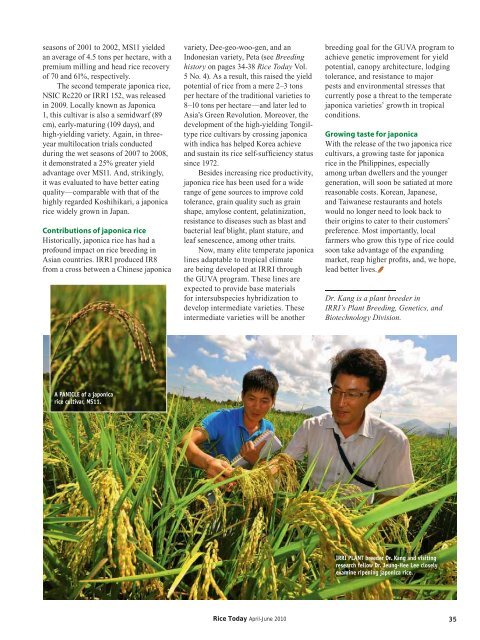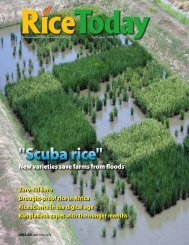A sunburned grain Stamps of approval Pockets of gold in ... - adron.sr
A sunburned grain Stamps of approval Pockets of gold in ... - adron.sr
A sunburned grain Stamps of approval Pockets of gold in ... - adron.sr
Create successful ePaper yourself
Turn your PDF publications into a flip-book with our unique Google optimized e-Paper software.
seasons <strong>of</strong> 2001 to 2002, MS11 yieldedan average <strong>of</strong> 4.5 tons per hectare, with apremium mill<strong>in</strong>g and head rice recovery<strong>of</strong> 70 and 61%, respectively.The second temperate japonica rice,NSIC Rc220 or IRRI 152, was released<strong>in</strong> 2009. Locally known as Japonica1, this cultivar is also a semidwarf (89cm), early-matur<strong>in</strong>g (109 days), andhigh-yield<strong>in</strong>g variety. Aga<strong>in</strong>, <strong>in</strong> threeyearmultilocation trials conducteddur<strong>in</strong>g the wet seasons <strong>of</strong> 2007 to 2008,it demonstrated a 25% greater yieldadvantage over MS11. And, strik<strong>in</strong>gly,it was evaluated to have better eat<strong>in</strong>gquality—comparable with that <strong>of</strong> thehighly regarded Koshihikari, a japonicarice widely grown <strong>in</strong> Japan.Contributions <strong>of</strong> japonica riceHistorically, japonica rice has had apr<strong>of</strong>ound impact on rice breed<strong>in</strong>g <strong>in</strong>Asian countries. IRRI produced IR8from a cross between a Ch<strong>in</strong>ese japonicavariety, Dee-geo-woo-gen, and anIndonesian variety, Peta (see Breed<strong>in</strong>ghistory on pages 34-38 Rice Today Vol.5 No. 4). As a result, this raised the yieldpotential <strong>of</strong> rice from a mere 2–3 tonsper hectare <strong>of</strong> the traditional varieties to8–10 tons per hectare—and later led toAsia’s Green Revolution. Moreover, thedevelopment <strong>of</strong> the high-yield<strong>in</strong>g Tongiltyperice cultivars by cross<strong>in</strong>g japonicawith <strong>in</strong>dica has helped Korea achieveand susta<strong>in</strong> its rice self-sufficiency statuss<strong>in</strong>ce 1972.Besides <strong>in</strong>creas<strong>in</strong>g rice productivity,japonica rice has been used for a widerange <strong>of</strong> gene sources to improve coldtolerance, <strong>gra<strong>in</strong></strong> quality such as <strong>gra<strong>in</strong></strong>shape, amylose content, gelat<strong>in</strong>ization,resistance to diseases such as blast andbacterial leaf blight, plant stature, andleaf senescence, among other traits.Now, many elite temperate japonical<strong>in</strong>es adaptable to tropical climateare be<strong>in</strong>g developed at IRRI throughthe GUVA program. These l<strong>in</strong>es areexpected to provide base materialsfor <strong>in</strong>tersubspecies hybridization todevelop <strong>in</strong>termediate varieties. These<strong>in</strong>termediate varieties will be anotherbreed<strong>in</strong>g goal for the GUVA program toachieve genetic improvement for yieldpotential, canopy architecture, lodg<strong>in</strong>gtolerance, and resistance to majorpests and environmental stresses thatcurrently pose a threat to the temperatejaponica varieties’ growth <strong>in</strong> tropicalconditions.Grow<strong>in</strong>g taste for japonicaWith the release <strong>of</strong> the two japonica ricecultivars, a grow<strong>in</strong>g taste for japonicarice <strong>in</strong> the Philipp<strong>in</strong>es, especiallyamong urban dwellers and the youngergeneration, will soon be satiated at morereasonable costs. Korean, Japanese,and Taiwanese restaurants and hotelswould no longer need to look back totheir orig<strong>in</strong>s to cater to their customers’preference. Most importantly, localfarmers who grow this type <strong>of</strong> rice couldsoon take advantage <strong>of</strong> the expand<strong>in</strong>gmarket, reap higher pr<strong>of</strong>its, and, we hope,lead better lives.Dr. Kang is a plant breeder <strong>in</strong>IRRI’s Plant Breed<strong>in</strong>g, Genetics, andBiotechnology Division.A PANICLE <strong>of</strong> a japonicarice cultivar, MS11.IRRI PLANT breeder Dr. Kang and visit<strong>in</strong>gresearch fellow Dr. Jeung-Hee Lee closelyexam<strong>in</strong>e ripen<strong>in</strong>g japonica rice.Rice Today April-June 201035

















